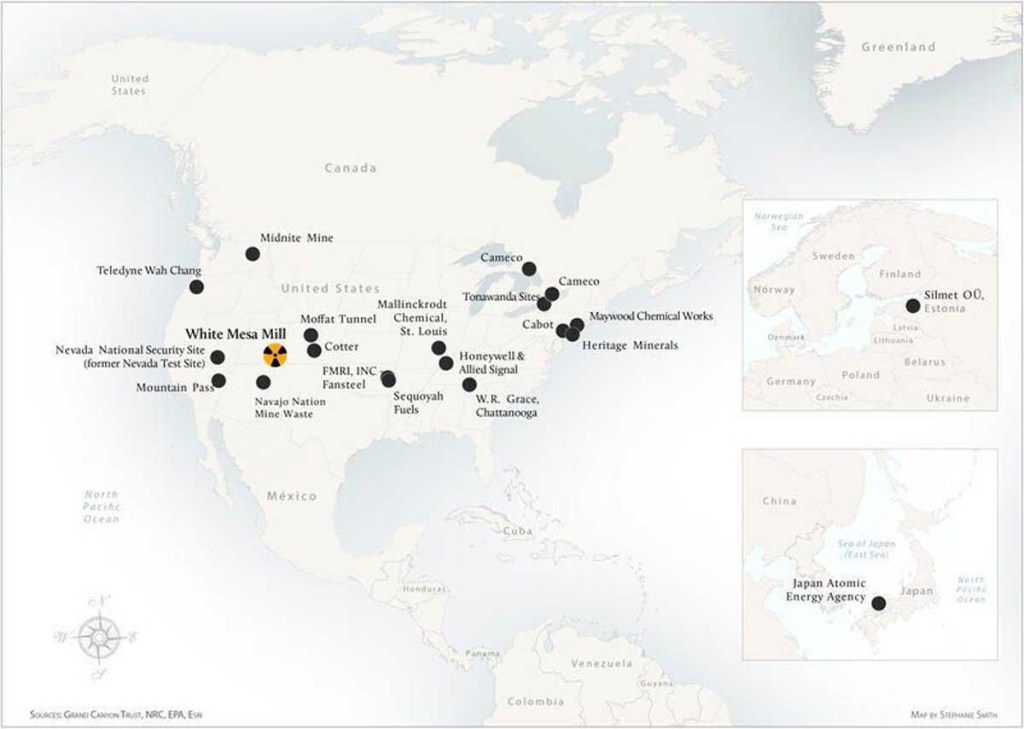Northeast Oklahoma uranium mill becomes waste dump
Published 3:58 pm Saturday, March 19, 2022

- Alternate feed source sites with wastes approved or considered for shipment, processing and burial at the White Mesa Mill (Source site names labeled, U.S. with international insets).
MUSKOGEE, Oklahoma – Problems related to contamination of radioactive waste generated at two Northeastern Oklahoma facilities shuttered decades ago have spread to a uranium mill in Utah – the last of its kind in the U.S.
A report released this week by the Grand Canyon Trust details how White Mesa Mill, the last functioning uranium mill in the U.S., has become “America’s cheapest radioactive waste dump.” The report, The Business of Radioactive Waste, chronicles how more than 700 million pounds of radioactive wastes wound up being buried in the mill’s waste pits a mile outside Bears Ears National Monument.
The authors of the report cite documents that trace 26 million pounds of radioactive waste to the shuttered Fansteel facility near the Port of Muskogee. The waste was a byproduct of Fansteel’s extraction of tantalum and columbium from ore and slag, which was pulverized then digested using hydrofluoric acid, and extracted from the acidic solution using an organic solvent.
Another 21.94 million pounds, according to the report, originated at Sequoyah Fuels near Gore, where the subsidiary of the Kerr-McGee Corp. purified and converted concentrated uranium ore, also known as “yellowcake.” From 1987 until 1993, the plant also converted uranium hexafluoride into uranium tetrafluoride, a process that created a separate waste stream.
Tim Peterson, cultural landscapes director for Grand Canyon Trust, said the mill presently is owned by Energy Fuels Resources. The plan initially was to operate for 10 to 15 years and mill uranium mined in the Four Corners Region and then close and reclaim the site.
“Now more than 40 years have past, and the mill is still operating,” Peterson said. “Not one of the mill pits has been reclaimed.”
Peterson said uranium prices historically have been “incredibly volatile,” and White Mesa Mill has reported poor profits during the past four decades. He said the mill has been able to stay open by transforming its business model.
“It’s cheaper for polluters to send their waste to a mill than it is to a licensed low-level radioactive waste disposal facility,” Peterson said. “It’s about half the cost to send it through the mill.”
U.S. Rep. Raúl Grijalva from Arizona, chairman of the House Committee on Natural Resources, said the mill represents a story that is “too common across the Western United States.”
“In an effort to extract as much profit as possible” these practices put “public health and clean water at risk,” Grijalva said.
“This is a very clear example to me of environmental injustice — a clear threat to tribal communities and other localities all for the benefit of one corporate actor,” Grijalva said. “Uranium has always been a dirty business and its toxic legacy is long and well documented.”
Grijalva said said White Mesa Mill should serve as a wake-up call for his colleagues and that corrective steps are taken to address the problems in Utah and its sources.
The authors of the report recommend the mill should be licensed and regulated as a disposal site rather than a mill. That would curb the inflow of additional radioactive materials and address the contamination that exists.
Cleanup continues at both sites in Oklahoma. Fansteel Metals filed a lawsuit in 2021 after emerging from bankruptcy against Muskogee City-County Port Authority and other defendants seeking contributions toward the costs of the cleanup. Inspection reports filed by the Nuclear Regulatory Commission indicate contaminated material remains at the Muskogee site.
NRC staff conducted a teleconference in January with representatives of Sequoyah Fuels, Oklahoma Department of Environmental Quality, Cherokee Nation and others to discuss groundwater contamination and corrective actions. The contaminated site is located near the confluence of the Lower Illinois and Arkansas rivers.





